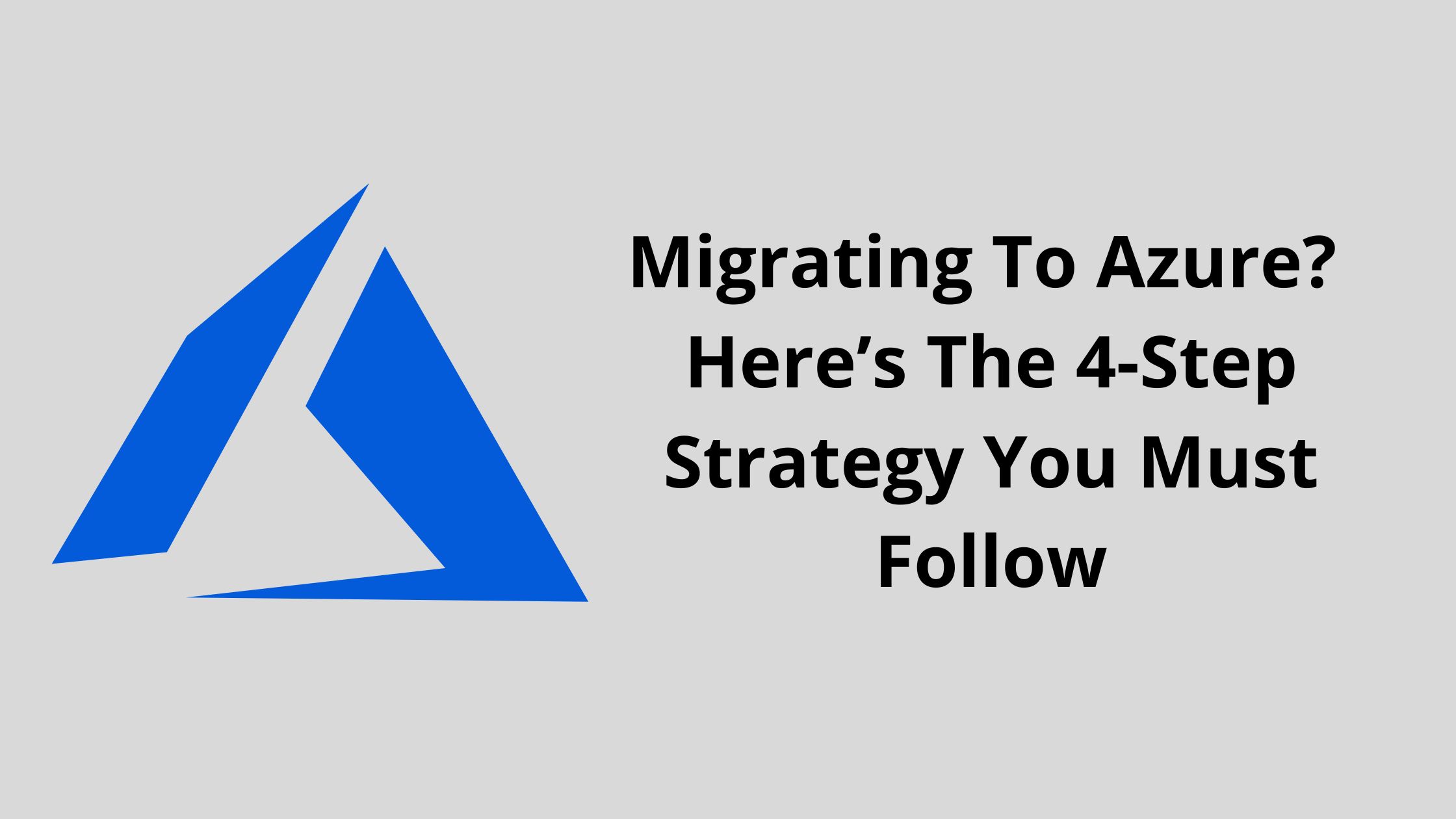Migrating To Azure? Here’s The 4-Step Strategy You Must Follow

Today, more than ever, businesses are moving their important workloads into the ‘cloud.’ As a relatively new term solution in the industry, most organizations are doubtful or confused about the different steps involved in the procedure.
However, there’s one common question among all the organizations, ‘which data migration service should I rely on?’
Choosing the best data migration service is one of the most important aspects of the procedure. There are several situations and reasons for data migration, including, but not limited to, database migration, backup migration, and lift-and-shift data of virtual machines.
Find yourself in a similar situation? Relax, it’s common! And to help you better, we’ve developed a detailed walkthrough of the most popular migrating option, Microsoft Azure. Continue reading as we explore the different aspects of this migration platform.
Microsoft Azure Cloud Migration: The Go-To Solution For Cloud Professionals!
When weighing your migration options, Microsoft Azure Cloud Migration services stand out as the most popular platform! Over 30% of technical professionals indicated that they were already using Microsoft Azure as it greatly enhances agility, efficiency, and stability.
But the road to upgrading is not smooth; switching to Azure may be costly and error-prone. To make this complicated, time-consuming, and expensive shift easy, quick, and effective, if you’re contemplating a migration, this article will help you with a complete Azure cloud migration strategy.
Why Migrate To Azure?
Microsoft Azure is a highly effective cloud platform best suited for business IT operations with strict safety and data protection needs. It has developed into an advanced cloud system over time. Therefore, Azure is wise if you wish to switch completely to the cloud or have a hybrid cloud architecture.
Now let’s examine how to migrate to the Azure cloud. Microsoft recommends the following four-step azure cloud migration strategy:
- Discover: List the software and workloads you use
- Assess: Index your apps and workloads
- Target: Identify where you want to move.
- Migrate: Make the move.
What does this mean, then? Let’s look more closely.
- Discover
This step includes locating all active workloads and apps to set up your migration system. It’s a long and arduous process, but it’s essential to success. In addition, you should ensure that your app catalog is fully updated because missed programs and workloads might cause problems later.
During the planning stage, remember to go through the following topics:
Virtual Networks
Check your on-premises operations in the current virtual or physical infrastructure and compare them to similar Azure cloud migration services. This way, you can keep the same data center’s security and stability while controlling expenses.
Suppose you want to supply your DNS servers via the platform’s Active Directory. In that case, you can include the necessary networking requirements, the number of subnets you’ll need to supply, and other relevant information.
Better Storage Solutions
Every time you use all your storage, you must keep buying more. Based on your data type, there are a few different Azure storage types to consider.
- Standard: It is only suitable for lighter loads and is available at a lesser price. The standard storage solution uses hard disk drives to store your data.
- Premium: It is used for heavy workloads and is quite expensive. This tier uses the faster and more modern solid state drives to store data.
- Hot: They are used for frequently viewed operational and business-related data.
- Cold: They are designed for data you expect to use no more than once per month.
- Archive: They are intended for data accessed once every once or after 180 days.
| Tier | Type | Storage Price | Retrieval Costs | Access Delay |
| Standard | HDD | Low | High | Hours |
| Premium | SSD, NVMe | Highest | Lowest | Microseconds |
| Hot | HDD | High | Low | Milliseconds |
| Cold | HDD | Medium | Medium | Milliseconds |
| Archive | Offline | Lowest | Highest | Hours |
- Assess
The next step is to assess your current infrastructure. You can use Microsoft’s proprietary tools, like
MVMRA (Microsoft’s Virtual Machine Readiness Assessment) Tool.
This tool does an automated assessment of your on-premises infrastructure, whether virtualized or physical, and offers a checklist for moving your workload to the cloud. After the evaluation, the tool produces a report outlining the workload characteristics and setup.
MAP (Microsoft Assessment And Planning) Toolkit
The MAP Toolkit is an automated assessment, evaluation, and reporting tool that safely evaluates IT infrastructures for different platform migrations.
You may carefully analyze and record all the programs, workloads, and procedures you now employ with the help of these tools.
- Target
After assessing your current infrastructure, it’s time to plan how to migrate your servers to Azure. Your three most probable targets are:
Lift And Shift.
This approach involves just moving everything, exactly as it is, to the cloud. While it may waste resources and be more expensive to run, it is an easy technique that doesn’t need much work when moving an application.
Application Evolution
With this approach, you can choose which parts of the application to migrate to the cloud rather than all at once. But the running costs of this approach can be higher.
Application Re-Architecting
This method involves disassembling and reconstructing an application with a more modern, scalable structure. By doing so, you avoid starting from scratch and may eliminate problematic code while enhancing functionality that is important to your organization. This approach is therefore perfect for legacy apps that cannot be removed since they still contribute to the business and offer uniqueness.
- Migrate
Following the ‘Targeting’ process, we enter the actual migration phase. To ensure you’re getting the most benefit from your cloud environment, you must routinely evaluate and improve your Azure Cloud Migration once it is finished.
You’ve reached a significant turning point in your cloud migration process once your apps are finally on the cloud. Once they reach this point, companies can start fine-tuning their cloud to ensure they’re using all of Azure’s capabilities.
Microsoft Azure services can simplify and speed up the migration process. The Azure Data Migration Assistant, which automates data transfers, the Azure Migrate service, which automates the migration of virtual machines, and the Azure Data Box, which enables you to transmit files to an Azure datacenter using specialized hardware equipment.
The Bottom Line
The Azure Cloud Migration is a complex process. Therefore, companies must have the necessary knowledge and hire or work with people who have experience in migration. Even with a thorough understanding of your existing systems and processes, architecting for public clouds necessitates a unique set of abilities.
However, once done, it is only a matter of time until you can make the most of this cloud-backed platform. So, now that you know the possibilities of Azure, what’s stopping you from stepping into the solution of tomorrow?






